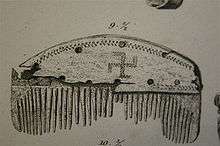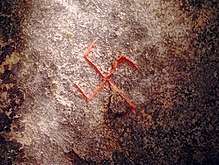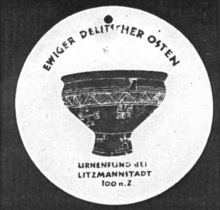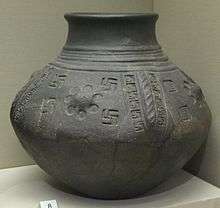Swastika (Germanic Iron Age)
The swastika design is known from artefacts of various cultures since the Neolithic, and it recurs with some frequency on artefacts dated to the Germanic Iron Age, i.e. the Migration period to Viking Age period in Scandinavia, including the Vendel era in Sweden, attested from as early as the 3rd century in Elder Futhark inscriptions and as late as the 9th century on Viking Age image stones.



In older literature, the symbol is known variously as gammadion, fylfot, crux gothica, flanged thwarts, or angled cross.[1] English use of the Sanskritism swastika for the symbol dates to the 1870s, at first in the context of Hindu and Buddhist traditions, but from the 1890s also in cross-cultural comparison.[2]
Examples include a 2nd-century funerary urn of the Przeworsk culture, the 3rd century Værløse Fibula from Zealand, Denmark, the Gothic spearhead from Brest-Litovsk, Belarus, the 9th century Snoldelev Stone from Ramsø, Denmark, and numerous Migration Period bracteates. The swastika is drawn either left-facing or right-facing, sometimes with "feet" attached to its four legs.[3]
The symbol is closely related to the triskele, a symbol of three-fold rotational symmetry, which occurs on artefacts of the same period. When considered as a four-fold rotational symmetrical analogue of the triskele, the symbol is sometimes also referred to as tetraskele.
The swastika symbol in the Germanic Iron Age has been interpreted as having a sacral meaning, associated with either Odin or Thor.[1]
Bracteates
A number of bracteates, with or without runic inscriptions, show a swastika. Most of these bracteates are of the "C" type, showing a human head above a quadruped, often interpreted as the Germanic god Woden/Odin.[3] The swastika in most of these cases is placed next to the head. The majority of these swastikas are left-facing (卍), but there are also a number of right-facing (卐) instances. In this context that the direction of the runic inscriptions on bracteates always is right-to-left (the mirror image of the stamp used to produce the bracteates), and in the transcription below the swastika is mirrored to preserve its directionality relative to the reading direction.
Examples where the swastika is part of the inscription include (DR being the Rundata province code for "Denmark"): DR BR12 Darum 4 (lïïaþzet lae : t卐ozrï);[4] DR BR38 Bolbro 1 and DR BR40 Allesø (both zlut : eaþl lauz 卐 owa );[5] DR BR41 Vedby (...] lauz 卐 owa ); DR BR53 Maglemose 2 (卍(l)kaz).[6]
Anglo-Saxon England

The early Anglo-Saxon ship burial at Sutton Hoo, England, contained numerous items bearing the swastika, now housed in the collection of the Cambridge Museum of Archaeology and Anthropology.[7] The Swastika is clearly marked on a hilt and sword belt found at Bifrons in Bekesbourne, Kent, in a grave of about the 6th century.
Interpretation
Hilda Ellis Davidson theorized that the swastika symbol was associated with Thor, possibly representing his hammer Mjolnir - symbolic of thunder - and possibly being connected to the Bronze Age sun cross.[7] Davidson cites "many examples" of the swastika symbol from Anglo-Saxon graves of the pagan period, with particular prominence on cremation urns from the cemeteries of East Anglia.[7] Some of the swastikas on the items, on display at the Cambridge Museum of Archaeology and Anthropology, are depicted with such care and art that, according to Davidson, it must have possessed special significance as a funerary symbol.[7] The runic inscription on the Sæbø sword (ca. AD 800) has been taken as evidence of the swastika as a symbol of Thor in Norse paganism.
See also
- Kolovrat
- Valknut
References
- George Stephens, The Runic Hall in the Danish Old-Northern Museum, Michaelsen and Tillge (1868). "[the Snodelev stone] is also remarkable in another way. Above the runes, on the left, are 3 Horns in the shape of a triskele, here doubtless the mark of thor. On the right side is the Flanged Thwarts, or pre-Christian 4-angled cross, here doubtless the mark of woden."
- e.g. Smithsonian Institution annual report, 1896, p. 796.
- Olaf Olsen; Ebbe Klovedal Reich; Klaus Rifbjerg; et al. (1990). Oldtidens Ansigt: Faces of the Past. p. 148. ISBN 978-8774682745.
- "photograph BR 12 (arild-hauge.com)".
- photograph BR38 (arild-hauge.com); photograph BR40 (arild-hauge.com)
- "photograph BR53 (arild-hauge.com)".
- H.R. Ellis Davidson (1965). Gods and Myths of Northern Europe, page 83. ISBN 978-0-14-013627-2, p. 83
External links
| Wikimedia Commons has media related to Swastikas in ancient Germanic culture. |